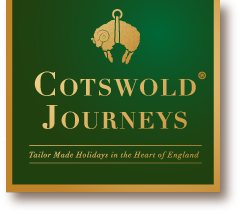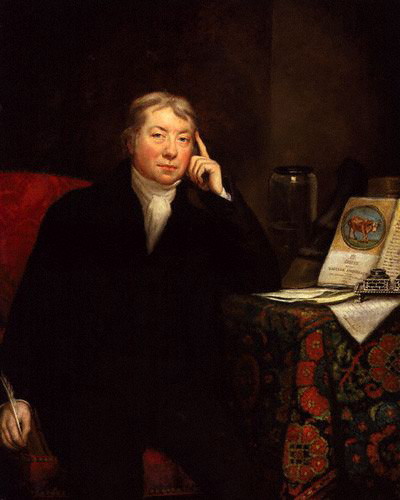Edward Anthony Jenner (17 May 1749 – 26 January 1823), widely credited as the pioneer of the smallpox vaccine, is sometimes referred to as the “Father of Immunology”; his works have been said to have “saved more lives than the work of any other man”.He was the eighth of nine children. His father was the vicar of Berkeley and so Jenner received a strong basic education, eventually studying at St. George’s Hospital in London. Returning to his native countryside by 1773 he became a successful general practitioner and surgeon, practicing in purpose-built premises at Berkeley.
Something was already known about the theory of inoculation. In 1765 Dr Fewster published a paper in the London Medical Society entitled “Cow pox and its ability to prevent smallpox” but did not pursue it further. From the 1770s there were several people in England and Germany who had successfully tested the possibility of using the cowpox vaccine as an immunization for smallpox in humans but it was not until Jenner’s work some twenty years later that the procedure became widely understood. Country lore had for long claimed that milkmaids did not generally get smallpox. Jenner wondered whether the poison in blisters arising from cowpox (a less virulent version of smallpox) conferred immunization. He may also have heard of attempts by Benjamin Jesty and others who deliberately infected their families with Cowpox, noticing a resulting reduced smallpox risk.
Smallpox was an infectious disease unique to humans, caused by either of two virus variants, Variola major and Variola minor, and is thought to have emerged about 10,000 BC. The name was first used in Europe in the 15th century to distinguish variola from the “great pox” (syphilis). The disease killed an estimated 400,000 Europeans per year during the closing years of the 18th century and was responsible for a third of all blindness.
On 14 May 1796, Jenner tested his theory by inoculating James Phipps, a young boy of eight years and the son of Jenner’s gardener (whose house still stands near the museum and is marked with a small plaque), with material from the cowpox blisters of the hand of Sarah Nelmes, a milkmaid who had caught cowpox from a cow called Blossom. This produced a fever but no great illness. Later, he injected Phipps with a small dose of smallpox (a procedure known as variolation) which at that period was the standard method of attempting to produce immunity. No disease had followed. Variolation had certainly been used in 16th century China (powdered smallpox scabs were blown up the noses of the healthy) and perhaps earlier in India.
Jenner continued his research and reported it to the Royal Society, who did not publish the initial report – skepticism being a trait of the medical establishment now. Finally, variolation was banned and vaccination was accepted. From 1840 it was offered free of charge on a voluntary basis and from 1853 under compulsion.
In 1821 he was appointed Physician Extraordinary to King George IV and was made Mayor of Berkeley. During his life, he was also fascinated by geology, ballooning, poetry, and natural history. In fact, it was Jenner who discovered that it was not adult cuckoos that ejected the occupants of the nests they annexed but the newly born chicks.
His interest in balloons was piqued by the first flights in France by the Montgolfier brothers and by similar attempts in England. Using the expertise of someone in England who had already launched a hydrogen balloon, Jenner launched his own balloon from the courtyard of Berkeley Castle at 2 p.m. on 2nd September 1784. It flew ten miles northeastwards, landing in a field at Kingscote. Relaunched, it drifted north along the line of the hills for a further fourteen miles, coming down again east of Gloucester on the escarpment at Birdlip. A local pub, known since the 1820s as the Balloon Inn and now called the Air Balloon Inn, may be named after this event.
Jenner’s contribution to medicine is less as a discoverer and more as a scientist who definitively proved that inoculation offered protection from smallpox. Smallpox has now been officially eradicated.
The Chantry
This was where Jenner lived much of his adult life and from where he pioneered vaccination against smallpox. He owned it from 1785 until his death in 1823. It was sold by his descendants in 1876. In 1885 it was sold again, to the Church of England, after which it became the vicarage for Berkeley, to replace the old vicarage where Edward Jenner had been born in 1749. When the Diocese of Gloucester decided to sell it in the early 1980s it was realized that it would be the ideal home for a museum to honor Jenner. The museum has a garden of about one acre, in which is located Jenner’s ‘Temple of Vaccinia’, a small 18th-century building of stone under a thatched roof. Decorated around its doorway and inside with large sections of bark from forest trees, it was here that Jenner vaccinated the poor people of the district, without charge. In the garden, too, is the vinery grown from cuttings Jenner brought back from Hampton Court; and the remains of a Saxon nunnery. Many of the rooms of the Chantry have an elegant period feel including Jenner’s former study, laid out as it would have been during his life, and dining room. The exhibition, which includes the iron bedsteads, chamber pots, and children’s games of the period, as well as stories, posters, photographs, and histories illustrating the devastating effects of smallpox and, therefore, the importance of Jenner’s contribution to world health, is highly evocative of the period in which he lived and an unadorned testament to his achievement.


0 Comments